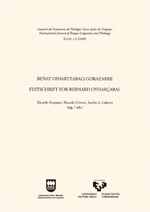Eredu latindarraren eragina euskal deklinabidearen XIX. mendeko deskribapenetan
##plugins.themes.bootstrap3.article.main##
##plugins.themes.bootstrap3.article.sidebar##
Argitaratua
2009-04-16
Ricardo Gómez
Laburpena
This paper explores the traces of the influence of the Latin grammatical tradition on the 19th-century descriptions of the Basque declension. For the purposes of the paper I describe that influence according to the following features: (1) the two-way distinction between singular and plural, with no mention of the indefinite number or mugagabe, and (2) the adaptation of the Basque case system to the six Latin cases. In the first decades of the 19th century, authors like Astarloa, Humboldt and Darrigol proposed some new ways of describing the Basque declension, which achieved a considerable success. Nevertheless, the weight of the Latin model remained strong, and it is clear that most of the 19th-century Basque grammarians who followed the Latin model were directly influenced by Larra men di: Garay de Monglave, Blanc, Lardizabal and Ribáry. However, some of the authors discussed here do not reveal such an influence: Hiriart and Gèze.
Nola aipatu
Gómez, Ricardo. 2009. «Eredu Latindarraren Eragina Euskal Deklinabidearen XIX. Mendeko Deskribapenetan». Anuario Del Seminario De Filología Vasca "Julio De Urquijo" 43 (1-2):405-21. https://doi.org/10.1387/asju.1712.
##plugins.themes.bootstrap3.article.details##
Atala
Artikuluak
Lan hau Creative Commons Aitortu-EzKomertziala-LanEratorririkGabe 4.0 Nazioartekoa lizentzia baten mende dago.


